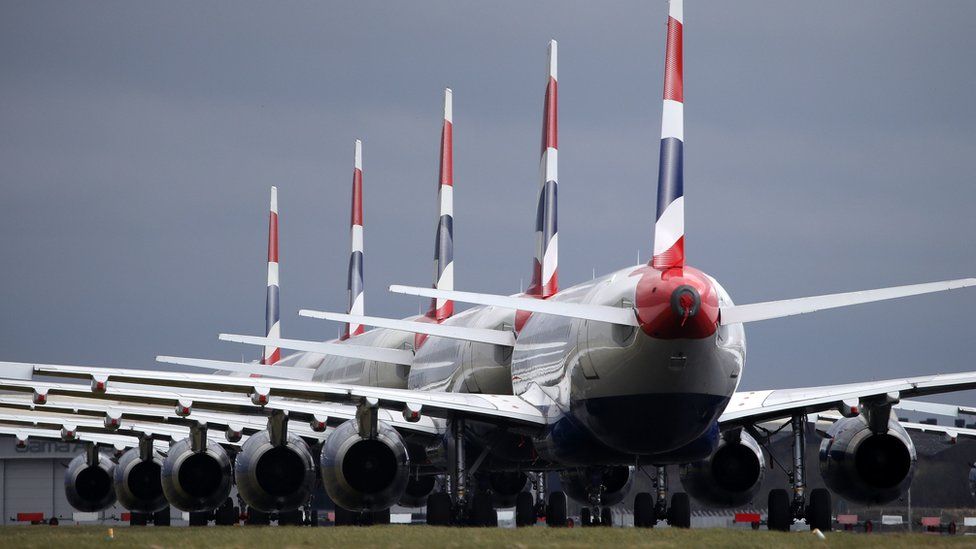International tourism not yet cleared for take-off
- Published

- While restrictions ease, city centres and international travel are far from recovery.
- Huge airline losses in 2020 are turning to some signs of recovery, though they won't necessarily be felt in Scottish airports for some time.
While even nightclubbers can get back to throwing some maskless shapes and 'vertical drinkers' will be allowed, from Monday, to prop up bars until they become horizontal, at least two parts of the economy still languish: city centres, bereft of office workers and their footfall, and international travel.
Staycations are booming across rural Britain. The most attractive places are rammed. My experience of Lochaber on Sunday was of being unable to find a parking space in most lay-bys.
But city centre hotels have very low occupancy and booking rates, and the Scottish Tourism Alliance is pushing ministers to support them further.
Part of their problem is in the lack of business travel, and international tourism.
Inbound and outbound, it looks likely to be the sector most likely to suffer a financial version of long Covid, and that's partly because vaccine nationalism has left large parts of the world lagging far behind with even a first jab.
"We're the only industry still effectively in lockdown," says pilots' union Balpa.
Relaxing rules for quarantine, including inbound travellers from France, the biggest international tourist destination, is being greeted with some relief in aviation circles. But the green list remains short.
A few countries are moving into less restricted categories, and Spain has avoided a downgrade. But beware of what's happening with Spain, warn UK and Scottish governments, a new variant has arrived there from South America.
However, the downgrade of Mexico, requiring quarantine after this Sunday, is a reminder that foreign travel remains highly unpredictable, and is bound to have a chilling effect on bookings.
According to Skyscanner, the Edinburgh-based booking website, the trends they are seeing are of more focused on shorter-haul breaks, to stay close to home. Long-haul is almost all about visiting friends and family.
Loss makers
To give some context, the global airlines organisation IATA has put out its figures for 2020, which shows the loss per passenger carried was US$71 (£51).
- 1.8 billion passengers flew, down 60%. Demand for air travel, measured in paying passenger-kilometres, dropped by 66%, and international was down 76%.
- The number of routes flown fell by more than 60% at the low point in April last year.
- Total passenger revenue fell 69% to $189bn (£136bn) and net losses were $126.4bn (£91bn).
- The data points to 41m passengers on international flights being British. At nearly 9% of the total, that's the second biggest nationality after the USA. Germans, French and Indians follow.
While cargo was a happier story for the industry, don't be surprised if airlines look to recoup those vast losses with higher prices than you might have seen before.
New planes, please
More recent figures for this year point to continued pain for the industry, and particularly in Europe. The number of flights in May was down 85% on the same month in 2019, and in June it was down 77%.
Paid passenger kilometres were down 69% on June 2019, with a global figure of -60%.
There are signs of recovery, even including the makers of aircraft Boeing and Airbus and engine-maker Rolls-Royce. It helps to have pressure to cut emissions with more efficient designs.
The US manufacturer has reported it is out of the red, after two very expensive years when it had to halt production of its latest 737 model due to faulty software causing them to crash.
Europe's Airbus reported an improved outlook on financials and orders, despite the dire straits facing its customers.
Rolls-Royce has today announced £307m profit for the first half of its year, compared with a £1.6bn loss this time last year.
What that means on the ground is harder to tell. The hub-and-spoke model of flying has been strengthened by the removal of less lucrative direct routes from airports such as Scotland's.
It may be some time yet before Edinburgh and Glasgow see the return of direct, long-haul flights linking with the Middle East and North America.
Airports and the many companies that feed off them, including the higher-spending end of the tourist industry, are not yet cleared for take-off.